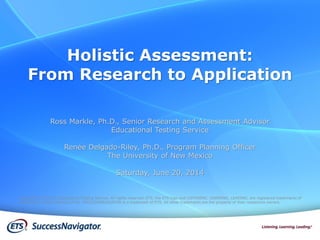The document discusses holistic assessment and its application to improve student success. It begins by outlining degree attainment rates which show that a significant portion of students, particularly underserved populations, do not complete a degree. It then discusses how holistic assessments that measure noncognitive skills can provide a more comprehensive understanding of students and help target support. The document presents the SuccessNavigator assessment as a tool that measures both cognitive and noncognitive skills to help with placement, advising, and planning support services. It provides an example of how the assessment could be used to recommend support services to a student and accelerate course placement when appropriate.

















![18
RECOMMENDATION
Student Name: [Name]
Student ID: [ID#]
Score Date: [Date]
The Student’s Background
• Gender: [Male/Female]
• Race: [Race]
• Age: [Age]
• Is English Best Language? [Yes/No]
Academic Skills – Tools and strategies to succeed in the classroom
Skills
• Sometimes uses strategies to effectively manage time and
assignments
• Occasionally misses class or comes unprepared
Tools/
Tips
Refer the student to the [Tutoring Center] to provide goal-
setting strategies and organizational tools. For additional ways of
working with the student, click here.
Commitment – Active pursuit toward an academic goal
Skills
• Sees great value in a college degree
• Is very attached to the college
Tools/
Tips
The [Career Center] can help the student align degree goals with
career goals. For additional ways of working with the student,
click here.
Social Support – Connections with people and resources for student success
Skills
• Holds strong connections to people and resources
• Effectively balances the demands of college and personal life
Tools/
Tips
The [Office of Student Life] can connect the student with valuable
student groups on campus. For helpful tools and tips about
student connections, click here.
Self-Management – Reactions to academic and other stressors
Skills
• Has difficulty managing stress in a positive, productive
manner
• Doubts personal skills and abilities
Tools/
Tips
Refer the student to the [Wellness Center] on campus to help
manage pressures and succeed. For effective ways of helping the
student manage everyday academic stress, click here.
MODERATE
ACADEMIC
SUCCESS INDEX*
HIGH
RETENTION
SUCCESS INDEX*
* Course Acceleration: Please see Technical User’s Guide to fully understand how to make an informed course placement.
* Academic Success Index: Weighted composite of student’s SuccessNavigator™ profile and other academic indicators of student preparedness, such as self- or institution-
reported high school GPA, SAT/ACT, etc.
* Retention Success Index: Projected likelihood that student will return for a second semester or year at the institution.
Advisor Report
SKILL REPORT
HIGH
HIGH
COURSE
ACCELERATION*
MODERATE
LOW
COURSE
ACCELERATION*
GLISH
MATH:CAUTION
ENGLISH: YES
Domain Scores: Four general
areas of student strengths
and weaknesses. Scores are
presented normatively.
Feedback: Determine by
more specific “facet” scores
(see next page).
Action Plans: Suggested
interaction with programs
and services on campus.
Background Information:
Communicate key student
information from both
SuccessNavigator™ and SIS
to faculty/advisor.
Success Indices: Separate
indices for both
classroom and
enrollment success.
Based on background,
cognitive and psycho-
social information and
supported by statistical
relationships with
success.](https://image.slidesharecdn.com/fa9f1149-a40b-496a-8db1-4db5359db9e7-151102160623-lva1-app6892/85/NASPA-AnP-2014-18-320.jpg)




















